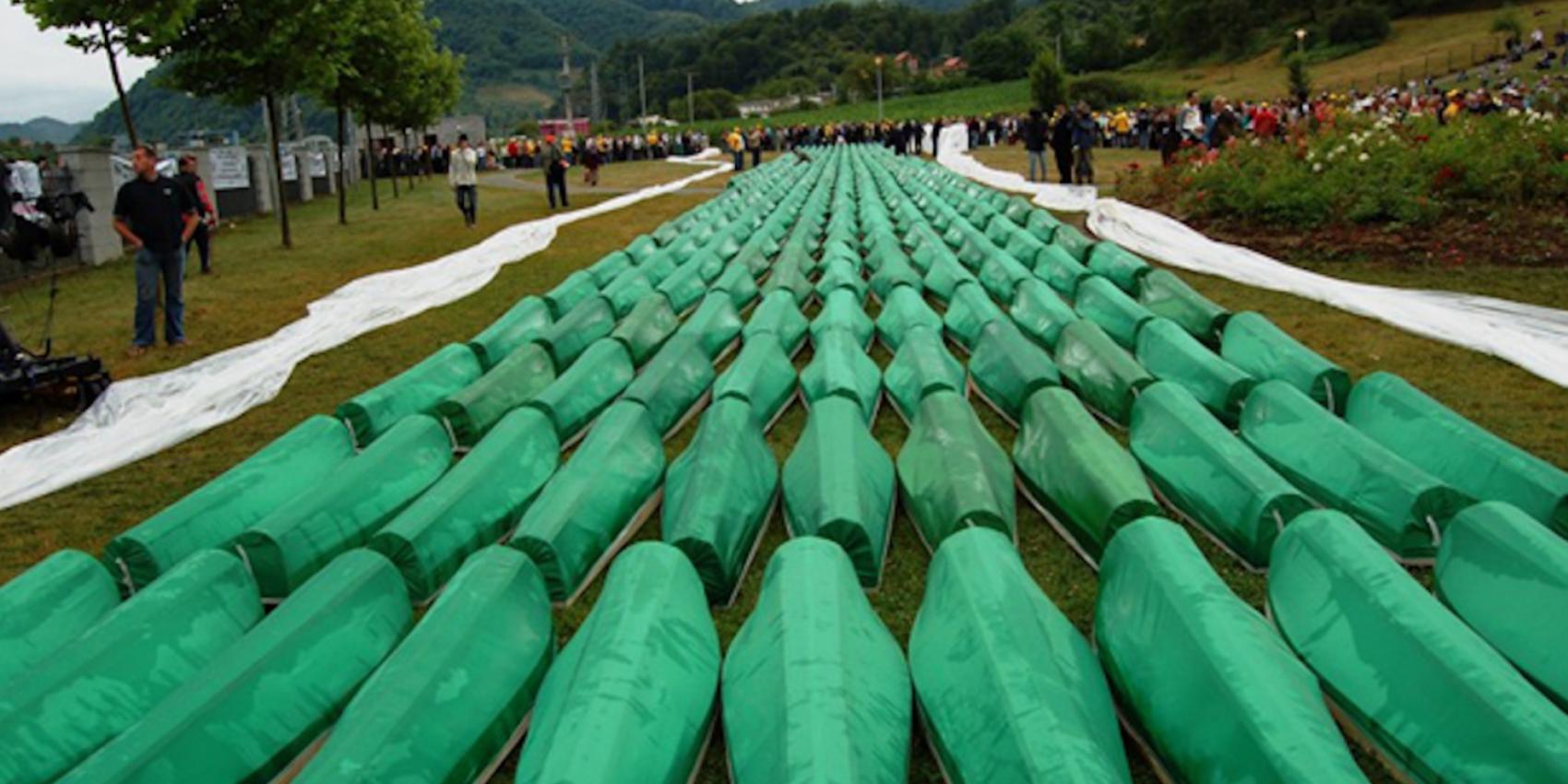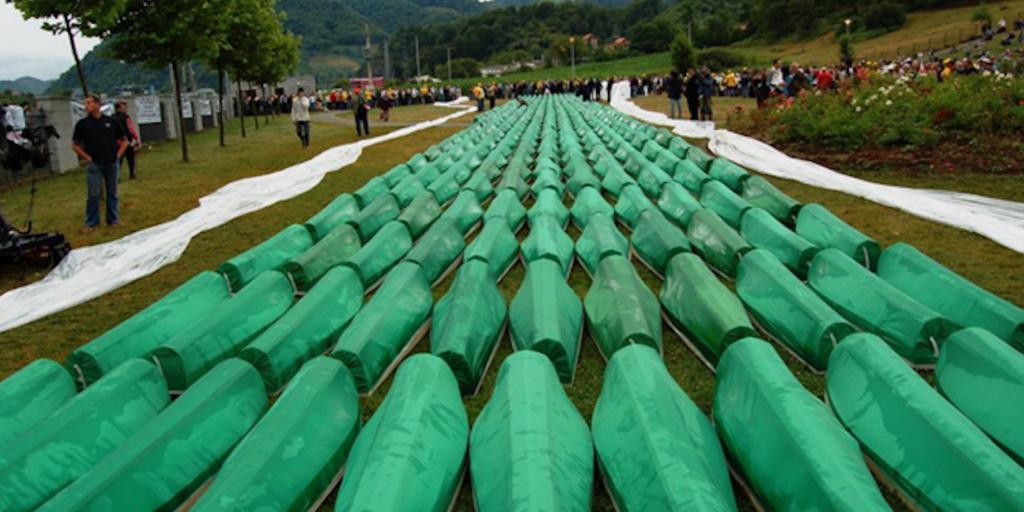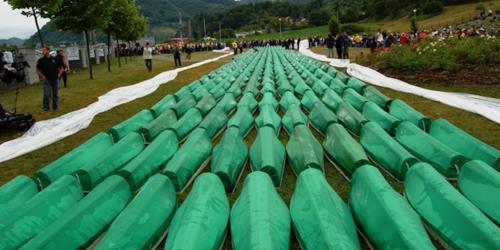According to Heike Karge, there are three main reasons why the state of “past perfect” has not been and will not be achieved in the close future for the families of the victims of the Srebrenica genocide. Besides the enormous forensic challenge of the primary and secondary gravesites, which is why not all the victims have been buried yet, and the issue of the juridical versus moral justice, she emphasizes the important issue of the recognition of the executions in July 1995 as genocide.[1]
The problem of recognition
In the period between 11 and 19 July 1995, the forces of the Army of Republika Srpska (VRS) executed over 8000 Bosniak men and boys in the aftermath of the takeover of this town in Eastern Bosnia and Herzegovina, while the women, children, and elderly were loaded onto buses and sent to the Bosniak-held territories.[2] These executions have been recognized as genocide by two international courts. The first recognition came from the International Criminal Tribunal for the Former Yugoslavia (ICTY) in the case against the VRS commander Radislav Krstić in 2004, determining that the genocide was committed in Srebrenica.[3] This stance was confirmed in the several cases related to Srebrenica which ensued,[4] concluding with the most recent completed trial of the former Bosnian Serb leader Radovan Karadžić, sentenced in March 2016. The ICTY process against general Ratko Mladić is still in process.
In 2007, the International Court of Justice ruled in the case of Bosnia and Herzegovina versus Serbia and Montenegro, concluding that “the acts committed at Srebrenica were committed with the specific intent to destroy in part the group of the Muslims of Bosnia and Herzegovina as such; and accordingly that these were acts of genocide, committed by members of the VRS in and around Srebrenica from about 13 July 1995”.[5] The court ruled that Serbia was not directly responsible for the Srebrenica genocide, but that it was nevertheless responsible for failing to prevent the genocide and for not punishing the perpetrators of it, addressing particularly the cooperation with the ICTY and at that time unsuccesful search for Ratko Mladić.
Naming it the denial syndrome, Sabrina Ramet argues that “a few Serbs are prepared to dwell on the suffering their nation caused to others, and dwell rather on their own suffering and the suffering of their heroes”.[6] Regardless of the international recognition, the Srebrenica genocide has not been acknowledged as such in Serbia and Republika Srpska. The Serbian parliament adopted the Declaration on Srebrenica in 2010, which condemned the crime committed in Srebrenica, apologizing to the victims' families for not doing everything to prevent the tragedy. Furthermore, the Declaration made a promise of the successful cooperation with the ICTY, especially in the case of finding and arresting Ratko Mladić, and invited all belligerent countries to work on the process of reconciliation. In the last Act, the parliament expressed the wish that other state institutions from the territory of former Yugoslavia would condemn the crimes against the Serbian population, as well as apologize and express sympathy to the victims' families.[7] A draft of a similar resolution was supposed to be adopted in Republika Srpska in May 2015 with the goal of acknowledging the genocide, but it failed. The President of Serbia Tomislav Nikolić publicly apologized to Bosnia and Herzegovina in 2013, but the apology did not include the acknowledgment of the genocide. At the same time, in both Bosnia and Herzegovina and Serbia there is no legislation on genocide denial, where in the case of Bosnia an attempt to adopt a law was obstructed by the Serbian representatives.
The Serbian policy of reconciliation
The Prime Minister of Serbia Aleksandar Vučić attended the central commemoration in Potočari on 11 July 2015, which is unprecedented in Serbian politics and could be perceived as a step ahead. While attending the memorial ceremony, he was attacked with stones and bottles. Afterwards he spoke in a positive tone, stressing out that he would nevertheless continue his policy of reconciliation and ascribing the attack to some marginal groups. The highest officials of the international community greeted his visit to Potočari as well as his reaction and persistence to work on reconciliation. At the same time, the commemorative gathering of 7000 people in front of the National Assembly back in Belgrade was banned.
Moreover, only a few days before the commemoration, Vučić celebrated the veto of the Russian Federation on the resolution on Srebrenica which was voted on in the United Nations Security Council on 8 July. Both he and Tomislav Nikolić, the President of Serbia, lobbied and spoke publicly against this resolution, representing it as depicting Serbian people as genocidal. Actually, the British draft resolution did not name the perpetrators of genocide at any point but it addressed the innocent victims “on all sides” very explicitly throughout the document. The last draft of the resolution had two general themes. First, it focused on the war in Bosnia, condemning the Srebrenica genocide and other massive human rights violations, expressing sympathy for all victims, and emphasizing acceptance of the events in Srebrenica as genocide as very important for reconciliation and inviting all political leaders to recognize it. Here, the document also discusses the cooperation with the ICTY and the process of reconciliation and conflict resolution in Bosnia and the region. Second, a large part of the resolution focuses generally on prevention of genocide and protection of civilian populations, recognizing the failure of the United Nations in preventing the Srebrenica genocide.[8]
The resolution was nevertheless misrepresented in the dominant political discourses both in Serbia and Republika Srpska, where the political leaders led the campaign against it. The failure to adopt the resolution was openly celebrated as victory. For example, driving through Republika Srpska in late July 2015, one could notice the posters depicting Vladimir Putin with the message “Thank you, President” written in the Cyrillic script in each village or town along the road.
The end of the Radovan Karadžić trial
It has to be noted that a significant part of the population of both Serbia and Republika Srpska still perceives Ratko Mladić and Radovan Karadžić as heroes and some of the political parties in power share this view. On 24 March 2016, Radovan Karadžić was sentenced to 40 years in prison for the series of crimes against humanity and violations of the laws or customs of war, including the genocide in Srebrenica.[9] The day of the last court proceeding overlapped with the anniversary of the beginning of the NATO bombing of Yugoslavia in 1999. As Karadžić's sentence was read in the afternoon, the registered protests about the NATO bombing by the Serbian Radical Party and far right organizations in Belgrade grew bigger. A few thousands of people went out to the streets, paralyzing the public transport. Among the Serbian flags and the Chetnik iconography, many people carried photographs of Radovan Karadžić and Ratko Mladić and the slogans depicting them as the Serbian heroes.
The negative reaction of the Serbian political leadership proved that the reconciliation rhetoric is only for the foreign use. Although this was not the first ICTY sentence for Srebrenica, as mentioned above, the Prime Minister and President interpreted the court decision as jeopardizing the existence of Republika Srpska. Aleksandar Vučić, who had been to Srebrenica last time only a few months earlier promoting his policy of reconciliation, warned that Serbia would not let the sentence to Karadžić to be used against Republika Srpska and stated that Serbia would not allow that someone walked over Serbs just because they were Serbs.[10] He announced that he would stand together with his people. Similarly, President Nikolić invited all officials of Republika Srpska to fight together “for their Republika Srpska and their people, whose destiny might be in question because of the court ruling”.
One step forward, two steps back
Although still present in the society, the narrative that the number of dead in Srebrenica was much lower than 8000 or that the victims were not civilians but combatants, is not predominant in Serbia at the same level as it was a few years ago (Republika Srpska is a different case in this concern). One could argue that the number politics and the complete denial of executions are at least no longer a part of the dominant political discourse. When the proposal for the resolution on Srebrenica was not adopted in Republika Srpska in 2015, Milorad Dodik, the President of Republika Srpska, said “No one denies that a crime happened in Srebrenica, but it was not a genocide”.[11] This statement summarizes the general attitude towards the Srebrenica genocide in Serbia as well, which has also been the official interpretation since the 2010 parliamentary Declaration on Srebrenica. The term “genocide” is avoided and substituted by a more acceptable term “crime”.
Regardless of the visit of Aleksandar Vučić to Srebrenica twice last year and his rhetoric of taking the path of reconciliation and the official apology of Tomislav Nikolić in 2013, it seems that each time a step forward is made concerning dealing with the ethnic cleansing and genocide in Bosnia, it is followed by two steps back. Both Vučić and Nikolić, as well as many other political actors, keep offending the victims' families and preventing closure by their inconsistent outbursts about Srebrenica in public. The general tendency in the public responses whenever Srebrenica becomes a dominant topic is the narrative of Serbian people and Republika Srpska as endangered and under attack as well as shifting the focus to the Serbian victims of the wars of the Yugoslav succession.
It has to be noted that both Vučić and Nikolić were members of the Serbian Radical Party of Vojislav Šešelj, endorsing the politics of ethnic cleansing of non-Serbian population in the 1990s and glorifying the war criminals afterwards. Moreover, while in the political opposition in 2007, Aleksandar Vučić led the initiative of putting posters with the inscription “Ratko Mladić Street” in Belgrade, as a part of the campaign by the Serbian Radical Party in support of Ratko Mladić. From the analysis of their public statements regarding the war in Bosnia and the lack of willingness to recognize the massive executions in Srebrenica as genocide, it can be also argued that they did not separate from their own problematic past. It remains to be seen what the Serbian officials will do on 11 July this year but, all in all, each initiative promoting the reconciliation has to be taken with precaution and observed through time and in the wider context.
Conclusion
The investigative work of the ICTY and the International Commission on Missing Persons, the testimonies of the perpetrators themselves and the survivors in the court, as well as the exhumations of the mass graves have generated a vast amount of evidence about the events in July 1995 in Srebrenica. The facts discovered so far testify that the Bosniak men and boys who were executed by the Bosnian Serbs forces were civilians, the numbers have been established, and the gathered evidence about the course of events in July 1995 supports the argument that the Srebrenica genocide was a planned action. Moreover, the mass executions were officially recognized as genocide by two international courts. Going back to Karge's arguments from the beginning of this article, there is still a lot to be done in order to achieve some level of satisfaction and closure for the victims' families. In this sense, the official recognition coming from Serbia and Republika Srpska would represent a large step forward.
[1] Heike Karge: Virulente Vergangenheit. 20 Jahre nach dem Völkermord in Srebrenica, Religion und Gesellschaft in Ost und West, 9, 2015, p. 12-15.
[2] For the description of the events, see: The International Criminal Tribunal for the Former Yugoslavia: Facts about Srebrenica.
[3] Appeals Judgement, Prosecutor v. Radislav Krstić, Case No.: IT-99-33, 19 April 2004.
[4] Zdravko Tolimir, Momir Nikolić, Dragan Jokić, Vidoje Blagojević, Dražen Erdemović, Dragan Obrenović.
[5] International Court of Justice: Case Concerning the Application of the Convention on the Prevention and Punishment of the Crime of Genocide (Bosnia and Herzegovina v. Serbia and Montenegro), Judgement, 26 February 2007, p.108.
[6] Sabrina Ramet: The Denial Syndrom and its Consequences: Serbian Political Culture Since 2000, Communist and Post-Communist Studies 40, 2007, 41-58, p.53.
[7] Deklaracija Narodne skupštine Republike Srbije o osudi zločina u Srebrenici.
[8] United Kingdom of Great Britain and Northern Ireland: Draft Resolution.
[9] The International Criminal Tribunal for the Former Yugoslavia: Trial Judgement Summary for Radovan Karadžić, 24 March 2016.
[10] Nikolić: Presuda ne sme da utiče na sudbinu naroda u RS (in: RS N1 vom 24.3.2016).
[11] "Our attitude is clear. No one denies that a crime happened in Srebrenica, but it was not a genocide, what Sarajevo keeps insisting on. We are sorry that the crime happened in that city and that many people died, although we have official information which speak about a much lower number of victims than those mentioned by the Bosniak politicians“. Dodik was sued for genocide denial, on the basis of its legal recognition by the two international courts.
Zitation
Jelena Đureinović, Extending the hand of reconciliation?. Remembering the Srebrenica genocide and its perpetrators in Serbia, in: Zeitgeschichte-online, , URL: https://zeitgeschichte-online.de/kommentar/extending-hand-reconciliation



